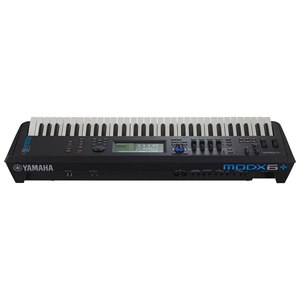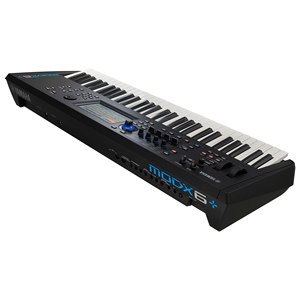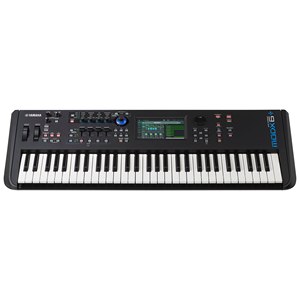(184382 products available)























































































































A synthesizer is an electronic musical instrument that generates audio signals to create music. These signals are usually converted into sound through speakers or headphones. Synthesizers are used to replicate sounds of traditional musical instruments like pianos and flutes. They can also produce unique sounds that no other instrument can make. Here are some common types of synthesizers:
Synthesizers are highly versatile musical instruments that can create or replicate various sounds. Here are some key usage scenarios:
Music Production
Synthesizers are fundamental tools for music production across various genres, including electronic, pop, hip-hop, rock, and film scoring. They are used to create lead melodies, basslines, pads, and even realistic instrument sounds. Modern music production heavily relies on synthesizers, especially in genres where electronic music dominates.
Sound Design
Sound designers use synthesizers to create unique sounds and auditory experiences. This is especially relevant in the film, TV, and video game industries, where new and otherworldly sounds are needed to enhance the immersive experience. From alien noises to atmospheric sounds, synthesizers are crucial tools in sound design.
Live Performances
Synthesizers are used in live performances to recreate the electronic elements of a performer’s or band’s recorded music. Performers can use hardware synthesizers, often combined with MIDI controllers and other equipment, to play music in a live setting. Modular synthesizers, in particular, can be visually impressive in live performances.
Educational Purposes
Synthesizers, especially those with a modular approach, are used in educational settings to teach students about sound, music production, and the technical aspects of creating music. They provide a hands-on experience that can be invaluable for music technology and production students.
Experimental Music
Artists who create experimental music often use synthesizers to explore new sounds and techniques. Synthesizers offer endless possibilities for experimentation, allowing artists to push the boundaries of music.
Therapeutic Use
While not as common, synthesizers have been used in music therapy to create sounds and music that can help in therapeutic settings. The act of creating music can be an emotional outlet, and the sounds produced can be calming and soothing.
Integration with Other Instruments
Synthesizers are often used in conjunction with traditional instruments. In many modern bands, synthesizers complement guitars, drums, and vocals to create a fuller, richer sound. They can also replace traditional instruments, providing a unique tone that can’t be achieved otherwise.
When planning to buy a synthesizer for sale, it is crucial to understand the different types and features. Here are some factors that business owners should consider while purchasing synthesizers to sell:
Type
As discussed earlier, synthesizers come in different types, such as analog, modular, virtual analog, and software synthesizers. Make sure to stock different types to meet the needs of various customers.
Sound Engines
The sound engine is a key feature of a synthesizer. Some customers will be looking for complex and rich sound engines. At the same time, others will be looking for simple sound engines. Consider stocking synthesizers with different sound engines to accommodate the needs of different customers.
Wavetable
Some synthesizers use wavetable synthesis. This method enables the creation of unique and evolving sounds. Customers looking for versatile sounds will prefer synthesizers with wavetable synthesis.
Sampling
Also, some synthesizers offer sampling capabilities. With sampling, sounds can be recorded, edited, and played back. It is an important feature for musicians and producers. Ensure to stock different types of sampling synthesizers.
Patch Bay
Some synthesizers come with a patch bay, especially modular synthesizers. A patch bay allows the rerouting of signals using patch cables. This gives users more control and creativity over sound design.
Polyphony and Monophony
Some synthesizers are monophonic and can only play one note at a time. Others are polyphonic and can play multiple notes simultaneously. Customers looking for synthesizers for playing chords and complex sounds will opt for polyphonic synthesizers.
Integration with DAWs
Many customers would want a synthesizer that can easily integrate with popular DAWs like Ableton Live, FL Studio, and Logic Pro X. This is important, especially for keyboardists and music producers who use DAWs to create and produce music.
Budget
Finally, consider the budget and price of the synthesizer. Some customers will be looking for affordable and basic synthesizers, while others will be looking for advanced synthesizers. Again, ensure to stock synthesizers of different prices to meet the needs of customers with different purchasing powers.
Below are some functions and designs of synthesizers inMusic Entertainment:
Modular Synthesizers
These synthesizers are delineated in separate modules that are connected with patch cables. Every module has a unique function, including oscillation, filtering, and modulation. This permits customizability and flexibility in sound design.
Subtractive Synthesizers
These synthesizers start with a rich, complex sound wave and use filtering to subtract harmonics, which results in a more straightforward sound. They are easy to use and sound fantastic, which makes them a popular choice for beginners.
Additive Synthesizers
These synthesizers create sounds by adding together simple sound waves, usually sine waves, at various frequencies and amplitudes. By carefully adjusting the amplitude of each frequency, additive synthesizers can create complex sounds.
FM Synthesizers
These synthesizers make sounds through frequency modulation. This involves modulating the frequency of one oscillator with another. This results in rich and complex sounds and timbres.
Granular Synthesizers
These synthesizers break samples into tiny fragments or grains, which are then manipulated and reassembled to create new sounds. This allows for the creation of unique and intricate sounds using existing samples.
Physical Modeling Synthesizers
These synthesizers use mathematical models to imitate the sound of physical instruments. By simulating the physical characteristics and behaviors of an instrument, they can create realistic sounds.
Hybrid Synthesizers
These synthesizers combine analog and digital technologies to create sounds. They often use analog oscillators and digital signal processing, which results in a wide range of sounds with the best of both worlds.
Wavetable Synthesizers
These synthesizers use a series of waveforms stored in a table that can be scanned and morphed to create different sounds. By varying the position in the table, a range of unique sounds can be produced.
Cathedral Synthesizers
These synthesizers are used to create reverberation effects that sound like large spaces, such as cathedrals. They are useful for adding depth and ambiance to sounds, making them more atmospheric and spatial.
Q1: What does a synthesizer do?
A1: A synthesizer generates audio signals that can be used to create music. The sounds can be in the form of rhythms, beats, or musical tones. It can also generate sounds for videos and games.
Q2: What is the difference between a synthesizer and a keyboard?
A2: A synthesizer generates sound, while a keyboard is an instrument used to play music. A synthesizer can have a keyboard attached, but it is not always a music-playing device.
Q3: What is the best synthesizer for beginners?
A3: The best synthesizer for beginners is a virtual analog synthesizer. It is user-friendly and has a simple interface. An example is the Korg Micro Monstro.
Q4: What is the difference between a modular and a hardware synthesizer?
A4: A modular and hardware synthesizer requires a patch cable to program sounds. The only difference is that a hardware synthesizer can be standalone or tabletop units, while a modular synthesizer is contained in a rack.
Q5: Can a synthesizer make vocal sounds?
A5: A synthesizer can create vocal sounds with a special tool called a vocoder. It uses the voice of the speaker and combines it with an audio signal to create vocal sounds.